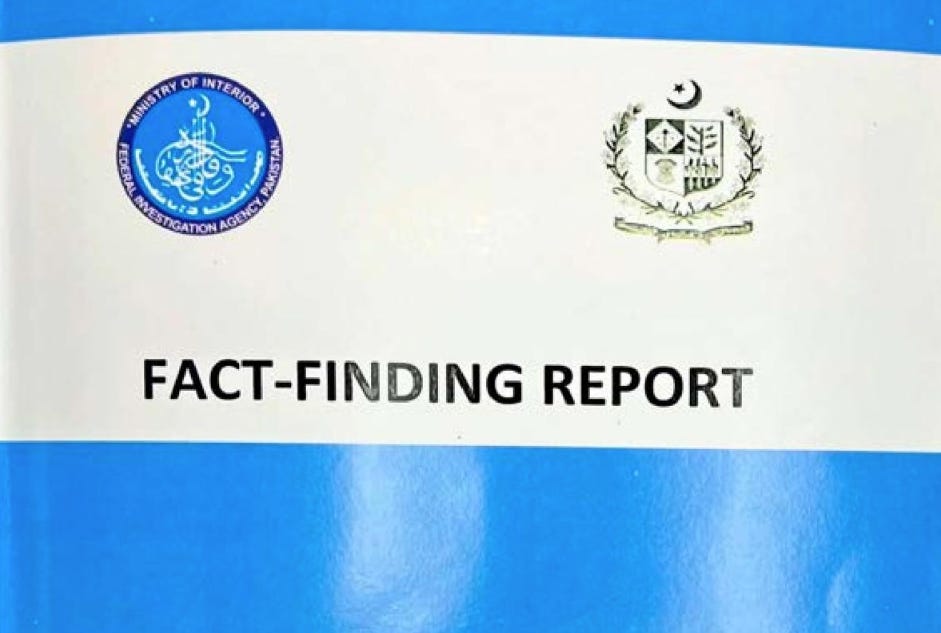Acclaimed Pakistani Journalist Arshad Sharif Was Tortured Before State Murder, Kenyan Court Concludes
The judge thoroughly rejected the state's flimsy claims

By Waqas Ahmed and Ryan Grim
In a landmark decision, a Kenyan judge has rejected the police defense in the 2022 shooting of acclaimed Pakistani journalist Arshad Sharif and ruled that he was tortured before his murder, according to court documents reviewed by Drop Site. In a scathing ruling, the court, in a decision released last week, further ruled his death was a violation of his human rights.
That Kenyan police killed Sharif, who was in exile and fleeing persecution from the Pakistani military, has never been in question. Kenyan police, for their part, have repeatedly offered contradictory and shifting explanations for Sharif’s killing. A key claim made by police—that somebody in Sharif’s car had fired at officers, striking one—was never mentioned during the court proceedings and is nowhere in the ruling, indicating that the explanation police had offered to the Pakistani Fact Finding Team, assembled to investigate the killing, could not be backed up with evidence of an injured officer. Sharif’s allies maintain he was hunted from Pakistan to the United Arab Emirates and then to Kenya, where he was finally assassinated, a claim buttressed by the court’s new ruling.
The case, brought forward by Sharif’s widow, Javeria Siddique, has now culminated in a decision that holds multiple state bodies accountable for their actions and opens up both the Pakistani and Kenyan governments to further scrutiny.
Sharif, known for his fearless reporting and criticism of the Pakistani military establishment, sought refuge first in the United Arab Emirates and then in Kenya after facing severe threats in his home country when the democratically elected government of Imran Khan was ousted under intense military pressure and a U.S.-backed vote of no confidence. Less than three months after leaving Pakistan, he was killed by Kenyan police on a dirt road while traveling from a camp in the outskirts of Nairobi. A leaked autopsy later revealed evidence that he may have been tortured.
His brutal murder in Kenya shocked the international journalism community and raised serious questions about the safety of exiled dissidents. Within Pakistan, there was a massive effort by the military to control the narrative around Sharif’s death and silence investigations into his killing. Similarly, in Kenya, a country whose military and economic ties with Pakistan run deep, investigations into the murder were shut down without explanation.
Sharif’s investigations often targeted influential figures, including Shehbaz Sharif, who was installed as prime minister following the ouster of Imran Khan. At the time of Sharif’s death, the Pakistani military was descending into one of darker moments, with the military-led government jailing thousands of activists, intensifying its censorship of the media, and tampering with elections.
The Kenyan Judge S.N. Mutuku noted in the final judgment, issued on July 8, that Siddique had to file the case a year after Sharif’s death because “no information was forthcoming…regarding the update of the status of the investigations or any action taken against the perpetrators of the shooting.”
The judgment holds several state bodies accountable, including the office of the Attorney General—which, the judge said, has a duty to advise on human rights matters—the police, and the Independent Policing Oversight Authority, or IPOA.
The police, identified as the “3rd Respondent” in the filing, were particularly scrutinized for failing to conduct an independent and effective investigation. “The 3rd Respondent has the responsibility to act on the recommendations of the Independent Policing Oversight Authority, including compensation to victims of police misconduct,” the judgment states. “Failure to conduct independent, prompt and effective investigations and commence prosecution or to complete those investigations or in any other manner act on the outcome of those investigations by the Respondents violated the positive obligation to investigate and prosecute violations of the right to life.”
Judge Mutuku’s decision also found that Sharif’s rights under Article 1 of the Convention Against Torture, or CAT, were violated and that he had been subjected to torture. Citing the CAT and the International Covenant on Civil and Political Rights, the judgment states that the Kenyan government failed in its duty to take appropriate action against those responsible for Sharif’s torture and should, “[T]ake into custody any person who may have committed torture under Article 4 of CAT and take appropriate action against such a person including prosecution.”
If that link isn’t working where you are, you can try this one.
Assassination or Mistaken Identity?
Arshad Sharif faced escalating threats before his untimely death. Following Khan’s ouster in 2022, the Pakistani government began registering fake cases against journalists, arresting and torturing reporters who critiqued the military-backed regime. Several police departments across the country filed sedition cases against Sharif, and on August 5, 2022, the Counter Terrorism Department in Khyber Pakhtunkhwa province issued an alert that his life was under threat. Sharif fled Pakistan for Dubai on August 10, 2022. However, on August 20, Sharif was instructed by Dubai authorities to leave the UAE, despite having several weeks left on his visa. That same day, Sharif flew to Nairobi at the invitation of Waqar Ahmed, a friend of a friend, and moved into a penthouse owned by Ahmed, according to a team of Pakistani investigators sent to Kenya to probe the killing.
Just two months later, Arshad Sharif was dead.
On October 26, 2022, the Pakistani government commissioned a Fact-Finding Team, or FFT, to investigate Sharif’s killing and send its findings to Kenya. Headed by prominent Pakistani author Omar Shahid Hamid, the team conducted various interviews with involved officers, visited the site of the killing, reviewed autopsy reports, and held meetings with Kenyan authorities, including the IPOA. The FFT’s final report, which was leaked to the media, offers a crucial window into the events surrounding Sharif’s death.
According to the report, Sharif left his apartment with Khuram Ahmed, Waqar's brother, on October 22, 2022. They traveled to the Kwenia Eco Lodge, where Waqar owned the Ammodump shooting range. Sharif spent the night and the next day at the range. On the evening of October 23, after attending a barbecue organized by Waqar, Sharif and Khuram Ahmed departed for Nairobi. According to police reports, a roadblock was set up around 9:30 p.m. by four officers with the General Service Unit, a paramilitary wing of the Kenyan police—ostensibly in response to reports of a stolen vehicle.
Khuram Ahmed, who was driving the car, said in a statement to the FFT that he saw stones on the dirt road—a common carjacking technique in Kenya—and panicked. He claimed that he heard gunshots and, sensing that Sharif had been wounded, drove to another farm owned by Waqar Ahmed, 25 kilometers away in Oltepesi. Upon arrival, he claimed, he discovered Sharif had been killed. The police initially claimed the incident was a case of mistaken identity—that officers believed the vehicle was the stolen one they claimed to be pursuing—but neither the number plate nor the description of the stolen vehicle in question nor the direction it was traveling matched that of Khuram’s car. Also, the stolen vehicle had been reported nearly a hundred kilometers away from the roadblock, and neither the FFT nor the judge lent the explanation any credence.
The story told by Khuram Ahmed does not remotely match the one told by police to the FFT, which in turn does not match the one police subsequently told to the Kenyan court. The discrepancies are not minor.
Speaking to the Pakistani investigators, the Kenyan police claimed someone in the car shot at them first, before they fired back. In those interviews, officials abandoned the mistaken identity claim entirely, instead alleging that when Khuram’s car failed to stop at the checkpoint, someone from inside the vehicle fired a shot at the police and sent a bullet through the left palm of one policeman, Constable Mutoko, seriously injuring him. When asked why they did not give chase as Khuram fled the scene, the police cited the need to attend to the injured officer. This is repeated multiple times in the FFT report, which casts doubt on the explanation, noting that Mutoko was armed with a Gilboa assault rifle that he somehow managed to fire three times with one hand. “Mutoko was the only officer from the four on the spot whom the FFT was not allowed to interview, on account of his still recovering from his injuries,” the report relays. “Therefore, whether he was even actually wounded or not, could not be independently verified.” The report further notes, “despite the urgency to leave to treat Mutoko”±the stated reason for not pursuing Sharif’s car—“the officers still had the time to pick up all their empty shell casings from the ground, an exercise that must have taken several minutes in the dark, even with a torchlight.”
These claims are absent from the first incident report submitted to the court, and the officers did not put forward this story at any point during their trial. The police reverted instead to the mistaken identity defense, which the judge firmly rejected in the final verdict.
“I didn’t even know that the police claimed in front of the FFT team that they were shot at,” Ochiel Dudley, Siddique’s attorney, told Drop Site News. “Had they claimed this in court, their case would have been much stronger, and they could have justified the shooting as self-defense.”
The FFT found many other discrepancies that have been corroborated by the court verdict. The team’s report notes that an autopsy conducted in Pakistan found signs of struggle on Sharif’s wrists, a fact missing from the autopsy conducted in Kenya. He also had four fingernails missing. The team noted that while Sharif was shot in the back, there was no bullet hole in the back of the passenger seat in which he was allegedly sitting at the time of his death. The shot to the head that finally killed him did not have corresponding blood splatter on the driver’s side of the car. “The injury had to have been caused either before Arshad Sharif got into the vehicle, or the shot was fired from a relatively close range, possibly from inside the vehicle, and and almost certainly not in a moving vehicle,” the report reads.
After the report became public, its lead author, Omar Shahid Hamid, was removed from his post at Pakistan’s Intelligence Bureau and the FFT was disbanded.
As Sharif’s widow and supporters continue to seek justice, this court decision fuels their belief that the Pakistani military colluded with Kenyan paramilitary forces to eliminate Sharif as a threat. In other eerily similar incidents, the Kenyan General Service Unit has blamed its extrajudicial killings on cases of mistaken identity. Last year, Sharif’s mother claimed in a letter to Pakistani courts that his assassination was planned in Pakistan and carried out by Kenyan authorities. She even explicitly named the Pakistani military officials she suspected. While the Pakistani Supreme Court took up the case in 2022, they have refused to hear the case since.
Now that the Kenyan courts have given support to the claim that Sharif’s death was a targeted assassination, Siddique told Drop Site that she has hope for justice. But she also fears for her own life.
If that link isn’t working where you are, you can try this one.
Documents referenced in the story:






I'm confused by Khuram Ahmed's role in this story and when the torture is alleged to have taken place. If Sharif was tortured, then Ahmed's story doesn't make sense, unless the torture occurred before Sharif was shot in the car. Does Khuram Ahmed say anything about Sharif being tortured prior to their drive back to Nairobi?
Why don't you stick your thick head where it rightly belongs?